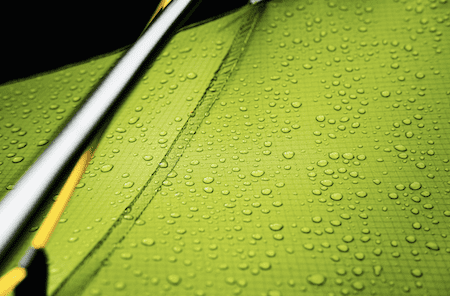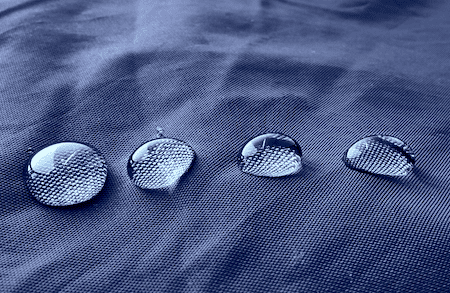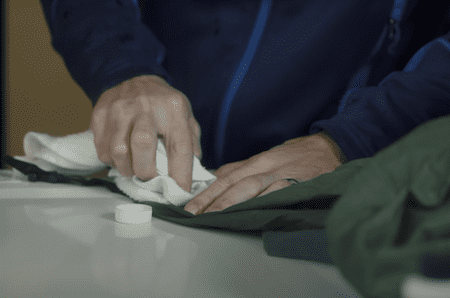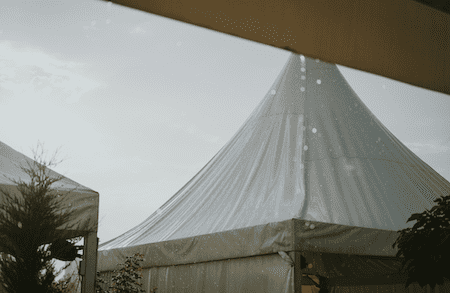Imagine backpacking through the mountains, setting up camp, only to wake up soaking wet because a spring rainstorm came through. Your gear is ruined, you have a cold, and you’re ready to call it quits.
Such an occurrence can happen to anyone, even those using canvas tents, known for their natural waterproofing capabilities.
Canvas can indeed prevent rain and other elements from getting into a tent well, but it’s not entirely waterproof.
Like everything good, canvas tents need the care to keep them dry, effective, and durable. And waterproofing is your first step to ensuring that.
In light of this, let’s learn how to waterproof canvas tents properly so you can enjoy dry and trouble-free nights under the stars while camping.
Does A Canvas Tent Need Waterproofing?
The first question that comes into every user’s mind is whether waterproofing a canvas tent is absolutely essential. It makes sense because the canvas is naturally durable with reasonably decent waterproof properties.
Raw canvas, however, doesn’t have full waterproofing capabilities despite its natural resistance to moisture. The fabric can still allow water to seep into the tent when heavy rainstorms hit hard.
So, if you want to make it entirely waterproof, you must spray it with either a fluoropolymer or silicone-based waterproofing spray.
If you choose not to waterproof your canvas tent, water will eventually seep into the fabric to some extent.
And even if the water doesn’t cause the inside to be overly wet, it can cause mold and mildew to grow sooner or later, leaving the door open to more and the inevitable stench over time.
Seasoning A Canvas Tent Before Waterproofing It
Most canvas tents aren’t waterproof right out of the box, no matter how good or bad. And why is that?
Because the fabric has micro pinholes that allow water to leak through the tent.
Some manufacturers treat each tent before sending it to market to prevent this issue, but most don’t.
Moreover, only a few of those do it well among those who do, and you don’t want to find that out when already at your campsite.
So, how do you go about dealing with the leaks? Indeed, you’ll waterproof them, which we’ll explain in the next segment, but you must prepare the tent well to ensure you do a good job. And ‘seasoning’ is what we mean by that.
Canvas tent seasoning means repeatedly soaking and drying it. It helps the fabric swell up and plug the micro pinholes, ensuring the waterproofing is effective and reliable.
The seasoning of canvas tents makes them durable enough to withstand heavy rainstorms or harsh weather conditions, for which they are known.
Seasoning a canvas tent is pretty straightforward.
Here’s what you need to do.
- First, set up the tent.
- Get a hose ready for cold water supply.
- Now use the hose to spray the tent. Be sure you don’t miss any of the fabric.
- After soaking it all up well, leave it to dry.
- Then repeat this process 3-4 times.
Alternatively, you can soak the tent in a tub and hang it on your laundry line after removing it from the tub.
Here’s one more thing – seasoning your tent should not be done only once, even when you have waterproofed it.
Be sure to repeat it yearly to maintain the effects.
What To Use For Waterproofing A Canvas Tent
Even though seasoning can substantially increase your tent’s waterproofing capabilities, it’s still necessary to waterproof it.
That’s because your tent’s fabric will loosen as it ages, causing the pinholes to reappear sooner than you might expect.
In contrast, the pinholes will remain sealed for a few more years if you waterproof the fabric after the seasoning. As for choosing the waterproofing product, two main options are available – fluoropolymer and silicone sprays.
While both materials use silicone rubber, fluoropolymer products are usually more resistant to weather, moisture, and oils than silicone by itself.
So, although either type of spray will do, we recommend using fluoropolymer spray.
You’ll want to choose a waterproof spray like this one from Scotchguard, which will not only keep your canvas tent dry against rain and snow but will also keep it breathable.
Besides the spray, you’ll also need some seam sealant to protect your seams. As you probably know seams are prone to letting water through.
The issue is perhaps more relevant for canvas tents, as they don’t have factory-sealed seams like nylon tents do.
5 Steps To Follow For Waterproofing Your Canvas Tent
You can waterproof a canvas tent easily. Just make sure you have the right products and take your time applying them.
Ideally, you should perform the following steps on a warm and sunny day when the wind is not too strong, for the spray will not spread evenly if the wind is too strong.
Step 1: Spread Out Your Tent
Place your tent on a flat surface after you have prepared your products. Spread it out entirely, so there’s no fold or crease; otherwise, lots of the portions may be left out.
Also, be sure you have enough space for moving around the tent fabric so that you can coat the entire exterior with ease.
Step 2: Thoroughly Clean Your Tent
You may find that some dirt has accumulated on the canvas surface of your tent if it isn’t brand new. This dirt needs to be removed before you start working on waterproofing.
A soft brush and a small amount of distilled white vinegar will be enough to accomplish this.
It’s a good idea to use one cup of vinegar per gallon of water as your cleaning solution. As an alternative, you can add a tablespoon of salt with a cup of lemon juice. Using this solution will also help you clean mold and mildew from a tent.
You can also use mild dish soap as an alternative, but you should never use products containing bleach. Blasting with bleach can make the canvas look faded while also damaging the fabric.
Once you have prepared your solution, take a cleaning brush, dip it, and lightly scrub each stained area of your tent.
Continue doing so until your tent is clean. It may be a good idea to hose down your tent using a light spray setting if your tent is incredibly dirty.
Step 3: Use Your Waterproofing Product
Once your tent is perfectly clean, you can begin using your waterproofing spray and the seam sealant. You should seal all seams between the floors and the walls with the seam seal.
If your product is a concentrated solution instead of spray, you can use a paintbrush for the application.
Depending on how much rain you expect, you may want to use the waterproofing spray on any areas that leak or the entire tent.
Always follow the manufacturer’s instructions when applying the waterproofing products. And be sure to apply the product evenly throughout each area.
Step 4: Test Your Work
Once the spray has dried in, pitch your tent and test it to see if the waterproofing spray has worked. The best way to do this is to drench your entire tent with a hose lightly.
Be sure to check for leaks inside the tent. If there were any, reapply your waterproofing spray to the areas that leaked.
Step 5: Let It Dry
Once your tent passes the test above, you can leave it to dry. But remember, when the canvas gets wet, it shrinks. So, you should stay on top of your tent assembly before letting it dry to avoid shrinking.
For speeding up the drying process, it’s okay to place it in the sun. UV light won’t harm the canvas, but you shouldn’t leave it out in the sun for too long.
FAQs
Do Canvas Tents Lose Their Waterproofing?
Yes, they do. A lack of maintenance may result in the waterproof coat wearing away.
Why Does My Canvas Tent Leak When I Touch It?
The surface tension of wet canvas draws water to your fingertip. While it appears to be leaking, it probably isn’t.
When Treated, How Waterproof Does The Canvas Tent Get?
The inside of a canvas tent is likely to stay entirely dry if you season and waterproof it properly.
Can You Waterproof Canvas Tents With Wax?
Sure, you can do it, and the results will be thoroughly satisfying. However, the wax coating breaks easily under pressure, which is pretty much the case while camping outdoors.
Meaning, you’ll have to re-coat it every time you go out.
Wrap Up
Tent seasoning is an extremely effective way to keep water out of a canvas tent, and waterproofing it with the right products completes the package.
And now that you know how to waterproof canvas tents the right way with the right materials and proper seasoning, you’re ready to go ahead and waterproof yours.
As a final note, we recommend repeating the processes we discussed every year, so you can stay dry inside your canvas tent every time you use it.
And undoubtedly, summer is the ideal time of year for doing this.







